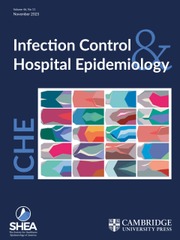Crossref Citations
This article has been cited by the following publications. This list is generated based on data provided by
Crossref.
Allegaert, Karel
2018.
Rational Use of Medicines in Neonates: Current Observations, Areas for Research and Perspectives.
Healthcare,
Vol. 6,
Issue. 3,
p.
115.
Patel, Sanjay V.
and
Vergnano, Stefania
2018.
The impact of paediatric antimicrobial stewardship programmes on patient outcomes.
Current Opinion in Infectious Diseases,
Vol. 31,
Issue. 3,
p.
216.
Godbout, Emily J.
Pakyz, Amy L.
Markley, John Daniel
Noda, Andrew J.
and
Stevens, Michael P.
2018.
Pediatric Antimicrobial Stewardship: State of the Art.
Current Infectious Disease Reports,
Vol. 20,
Issue. 10,
Flannery, Dustin D.
and
Puopolo, Karen M.
2018.
Neonatal Antibiotic Use: How Much Is Too Much?.
Pediatrics,
Vol. 142,
Issue. 3,
Klingenberg, Claus
Kornelisse, René F.
Buonocore, Giuseppe
Maier, Rolf F.
and
Stocker, Martin
2018.
Culture-Negative Early-Onset Neonatal Sepsis — At the Crossroad Between Efficient Sepsis Care and Antimicrobial Stewardship.
Frontiers in Pediatrics,
Vol. 6,
Issue. ,
Zheng, Ge
Pan, Minli
Li, Zhishu
Xiang, Wenna
and
Jin, Weimin
2018.
Effects of vitamin D on apoptosis of T-lymphocyte subsets in neonatal sepsis.
Experimental and Therapeutic Medicine,
Li, Jing-yang
Chen, Shang-qin
Yan, Yan-yan
Hu, Ying-ying
Wei, Jia
Wu, Qiu-ping
Lin, Zhen-lang
and
Lin, Jing
2018.
Identification and antimicrobial resistance of pathogens in neonatal septicemia in China—A meta-analysis.
International Journal of Infectious Diseases,
Vol. 71,
Issue. ,
p.
89.
Bio, Laura L.
Kruger, Jenna F.
Lee, Betty P.
Wood, Matthew S.
and
Schwenk, Hayden T.
2018.
Predictors of Antimicrobial Stewardship Program Recommendation Disagreement.
Infection Control & Hospital Epidemiology,
Vol. 39,
Issue. 7,
p.
806.
Klatte, J. Michael
Knee, Alexander
Szczerba, Frank
Horton, Evan R.
Kopcza, Kathleen
and
Fisher, Donna J.
2019.
Identification of High-Yield Targets for Antimicrobial Stewardship Program Efforts Within a Nonfreestanding Children’s Hospital.
Hospital Pediatrics,
Vol. 9,
Issue. 5,
p.
355.
Thampi, Nisha
Shah, Prakesh S.
Nelson, Sandra
Agarwal, Amisha
Steinberg, Marilyn
Diambomba, Yenge
and
Morris, Andrew M.
2019.
Prospective audit and feedback on antibiotic use in neonatal intensive care: a retrospective cohort study.
BMC Pediatrics,
Vol. 19,
Issue. 1,
Lu, Chunmei
Liu, Qing
Yuan, Hao
and
Wang, Laishuan
2019.
Implementation of the Smart Use of Antibiotics Program to Reduce Unnecessary Antibiotic Use in a Neonatal ICU: A Prospective Interrupted Time-Series Study in a Developing Country.
Critical Care Medicine,
Vol. 47,
Issue. 1,
p.
e1.
Willis, Zachary
and
de St. Maurice, Annabelle
2019.
Strategies to improve antibiotic use in the neonatal ICU.
Current Opinion in Pediatrics,
Vol. 31,
Issue. 1,
p.
127.
Dukhovny, Dmitry
Buus-Frank, Madge E.
Edwards, Erika M.
Ho, Timmy
Morrow, Kate A.
Srinivasan, Arjun
Pollock, Daniel A.
Zupancic, John A.F.
Pursley, DeWayne M.
Goldmann, Donald
Puopolo, Karen M.
Soll, Roger F.
and
Horbar, Jeffrey D.
2019.
A Collaborative Multicenter QI Initiative to Improve Antibiotic Stewardship in Newborns.
Pediatrics,
Vol. 144,
Issue. 6,
Grammatico-Guillon, Leslie
Abdurrahim, Lukman
Shea, Kimberley
Astagneau, Pascal
and
Pelton, Stephen
2019.
Scope of Antibiotic Stewardship Programs in Pediatrics.
Clinical Pediatrics,
Vol. 58,
Issue. 11-12,
p.
1291.
Karabay, Meltem
Kaya, Gulsum
Hafizoglu, Taner
and
Karabay, Oguz
2019.
Effect of camera monitoring and feedback along with training on hospital infection rate in a neonatal intensive care unit.
Annals of Clinical Microbiology and Antimicrobials,
Vol. 18,
Issue. 1,
Balkhy, Hanan H.
El-Saed, Aiman
AlShehri, Ali
Alshaalan, Mohammad
Hijazi, Omar
El-Metwally, Ashraf
Aljohany, Sameera M.
and
Al Saif, Saif
2019.
Antimicrobial consumption in three pediatric and neonatal intensive care units in Saudi Arabia: 33-month surveillance study.
Annals of Clinical Microbiology and Antimicrobials,
Vol. 18,
Issue. 1,
Greenberg, Rachel G.
Chowdhury, Dhuly
Hansen, Nellie I.
Smith, P. Brian
Stoll, Barbara J.
Sánchez, Pablo J.
Das, Abhik
Puopolo, Karen M.
Mukhopadhyay, Sagori
Higgins, Rosemary D.
and
Cotten, C. Michael
2019.
Prolonged duration of early antibiotic therapy in extremely premature infants.
Pediatric Research,
Vol. 85,
Issue. 7,
p.
994.
Kitano, Taito
Takagi, Kumiko
Arai, Ikuyo
Yasuhara, Hajime
Ebisu, Reiko
Ohgitani, Ayako
Kitagawa, Daisuke
Oka, Miyako
Masuo, Kazue
and
Minowa, Hideki
2019.
A simple and feasible antimicrobial stewardship program in a neonatal intensive care unit of a Japanese community hospital.
Journal of Infection and Chemotherapy,
Vol. 25,
Issue. 11,
p.
860.
Allegaert, Karel
Simons, Sinno
and
Van Den Anker, John
2019.
Research on medication use in the neonatal intensive care unit.
Expert Review of Clinical Pharmacology,
Vol. 12,
Issue. 4,
p.
343.
Adams, Susan M.
Ngo, Linh
Morphew, Tricia
and
Babbitt, Christopher J.
2019.
Does an Antimicrobial Time-Out Impact the Duration of Therapy of Antimicrobials in the PICU?*.
Pediatric Critical Care Medicine,
Vol. 20,
Issue. 6,
p.
560.

